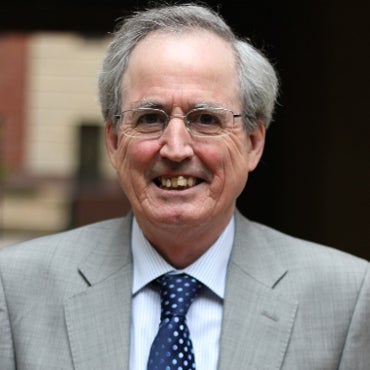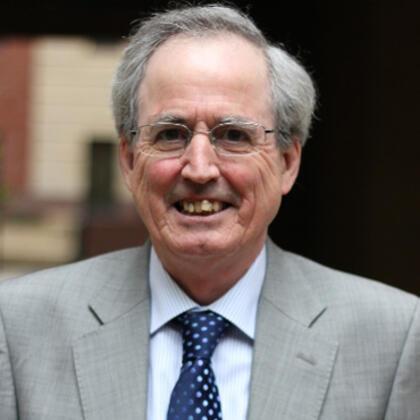Ghosts of Departed Quantities: Calculus and its Limits
Share
- Details
- Transcript
- Audio
- Downloads
- Extra Reading
In 1734 Bishop Berkeley published a witty and effective attack on the foundations of the calculus as developed by Newton and Leibniz. But it took nearly 90 years for the calculus to be given a rigorous foundation through the work of the prolific mathematician, Augustin-Louis Cauchy, who formalised the concept of a limit and created the specialism now called analysis.
This is a part of the lecture series, Shaping Modern Mathematics. The other lectures in the series are as follows:
Polynomials and their Roots
From One to Many Geometries
The Queen of Mathematics
Are Averages Typical?
Modelling the World
Download Transcript
25 September 2012
Ghosts of Departed Quantities:
Calculus and its Limits
Professor Raymond Flood
In 1734 Bishop Berkeley published a witty and effective attack on the foundations of the calculus as developed by Newton and Leibniz. But it took nearly 90 years for the calculus to be given a rigorous foundation through the work of the prolific mathematician, Augustin-Louis Cauchy, who formalised the concept of a limit and created the specialism now called analysis.
I want to first of all outline my programme of lectures this year and why I have chosen them.
The 17th and 18th centuries witnessed the beginnings of modern mathematics. New areas of the subject came into being — notably, the calculus — while others, such as number theory, were reborn or took on a new lease of life. Fundamental problems, such as that of determining the orbits of the heavenly bodies, were solved or investigated with novel techniques. It was the age of Newton in England, Descartes and Pascal in France, and Leibniz in Germany. It was also the age of gatherings – the formation of national scientific societies, such as London’s Royal Society and the Academy of Sciences in Paris, and the founding of scholarly institutions such as the St Petersburg Academy and the Academy of Sciences in Berlin. And, of course, Gresham College was founded, in 1597, just on the eve of the 17th Century!
The following 19th century saw the development of a mathematics profession in which people earned their living from teaching, examining and researching. The mathematical centre of gravity moved from France to Germany, while Latin gave way to national languages for publishing mathematical work. There was also a dramatic increase in the number of textbooks and journals. Because of this increase in mathematical activity, mathematicians began to (indeed, needed to) specialize. While one would use the term mathematician in the 18th century, by the 19th century, they described themselves as analysts, algebraists, geometers, number theorists, statisticians and applied mathematicians, terms which the mathematicians themselves evolved. This need for specialization was avoided only by the very greatest.
In each specialism there was a revolution - as well as an evolution - in its depth and extent. But each discipline experienced a movement towards an increasingly abstract style, with an increased emphasis on putting mathematics on a sound and rigorous basis and examining its foundations.
Lectures at the Museum of London
In my lectures this year I will look at the developments that shaped six of these areas:
Calculus Today
Algebra in November
Geometry in December
Number Theory in January
Statistics in February
and
Applied Mathematics in March
In each lecture I will introduce the problems that were worked on, the main people involved and crucially the core ideas and techniques that were developed. And I intend to do it an accessible, interesting, stimulating and informative way.
So to begin with the calculus.
Ghosts of Departed Quantities
I want tointroduce the calculus using the ideas of motion, tangents and areas and calculate them in some cases. This will bring in some of the work of Newton and Leibniz, their magnificent achievements and their squabbling. A more important controversy was with Bishop Berkeley who drew attention to the shaky logical foundations of the calculus and I will finish with how a resolution to the difficulties Berkeley raised was obtained.
Let’s start with motion, the change of position with time, to explain the underlying ideas and problems. For example, if we know the distance we have travelled at each time during a journey what is our speed at each time? And, conversely, if we know the speed at each point in our journey how do we find out how far we have gone at each time in the journey?
The word calculus is, perhaps off-putting. In general a calculus is just a particular system or method of calculation and of reasoning. In Latin, where the word comes from, the original meaning of a calculus is a pebble or stone used for reckoning and for calculation.
The calculus I want to talk about is made up from two seemingly unrelated strands, now called differentiation and integration, and is probably the most important mathematical technique ever devised and later we shall see examples of its use.
What is the Calculus: Integration
The first part of the calculus, Integration, is used to find areas of shapes in two-dimensional space or volumes in three dimensions. Here we have a straight line, and integration just means finding the areas under the line and above the horizontal axis. Here I’ve shown one such area, the area under the line from zero up to two.
Work on some of these problems went back a long time, for example, to Archimedes - a native of Syracuse on the island of Sicily and one of the greatest mathematicians
Archimedes (c287 - 212 BC)
Of all time -who in the third century BC made impressive calculations of the volumes of spheres, cones and cylinders, such as his celebrated result (which he wanted engraved on his tomb) that the volume of a cylinder is 11/2 times that of the sphere it surrounds.
The second part of the calculus, Differentiation, is concerned with how fast things move or change, and is used in the finding of velocities and tangents to curves. It is concerned with the rate of change.
Differentiation
Here I’ve shown a curve and the tangent to it at a particular point. The tangent just touches the curve. Work on tangents was also being done in the third century BC by Apollonius, known since antiquity as ‘the Great Geometer’, who wrote a famous book on conic sections.
Apollonius’ Conics
The conic sections are curves obtained by slicing a cone in various ways. This gives the following curves:
• slicing it horizontally gives a circle
• slicing it at a slant gives an ellipse
• slicing it parallel to the side of the cone gives a parabola
• slicing it vertically gives a hyperbola
Among other things, Apollonius investigated properties of the tangents to conic sections. After the invention of printing in the 15th century, many Greek writings appeared in book form. Here we see the beautiful frontispiece of a 1710 edition of the Conics by Edmond Halley (of ‘Halley’s comet’ fame). This depicts the Greek philosopher Aristippus, shipwrecked with his fearful colleagues on the island of Rhodes; on noticing some geometrical figures drawn in the sand, Aristippus exclaimed
‘Let us be of good cheer, for I see the footprints of men’.
Classical Greek Texts
Indeed this story of Aristippus landing on Rhodes was carried on during the 18th century in publications of classical Greek texts with on the left David Gregory’s 1703 edition of Euclid’s Elements with Propositions from Euclid drawn this time on the sand.
In the middle, as we have seen, Halley’s 1710 edition of Apollonius with conic sections drawn in the sand.
On the right, the 1792 Torelli edition of Archimedes and this time with a spiral, in fact an Archimedean spiral, drawn in the sand.
But, let us return to our main story. As the 17th century progressed, it was gradually realized that these two strands of finding tangents and of finding areas are intimately related.
A Characterisation of the Calculus
It was Isaac Newton and Gottfried Leibniz who in the 17th century independently developed what we now call the calculus which can be thought of as:
A systematic way of finding tangents
A systematic way of finding areas
A profound connection between tangency and area problems.
We will see later that finding tangents and finding areas are inverse processes — that means that, if we follow either process by the other, we return to our starting point.
Newton and Leibniz had different motivations in developing the calculus, with Newton focusing on motion and Leibniz concerned with tangents and areas.
Let us start with Newton. Here is Godfrey Kneller's fine 1689 portrait of Isaac Newton at age 46.
Isaac Newton
Isaac Newton was born on Christmas Day 1642 in the hamlet of Woolsthorpe, near Grantham in Lincolnshire. This is the date by the Julian calendar then in force in England; for the rest of Europe already using the modern Gregorian calendar the date was 4th January 1643. He went to Cambridge University where he was later appointed Lucasian Professor of Mathematics at the age of 26, staying in post for over 25 years until 1696 when he moved to London to become Warden, and then Master, of the Royal Mint. He became President of the Royal Society in 1703.
He remains, I believe, unchallenged in the depth and breadth of his mathematical and scientific work. He developed the general form of the binomial theorem, explained the relationship between differentiation and integration, studied power series, and analysed cubic curves. In gravitation, Newton asserted that the force that causes objects on earth to fall is the same as the one that keeps the planets orbiting around the sun, and that they are both governed by a universal law of force.
To illustrate Newton’s approach to differentiation let us think of a concrete situation where we drop some object from a height.
Dropping ball 1
If we were to do so we could measure the distance fallen after 1 second, 2 seconds, 3 seconds and so on. If we did so we would see that the ball was covering greater and greater distances per second as it falls, in other words the ball is going faster and faster as it falls or, another way to put it, it is accelerating. If we ignore air resistance we would find that the distance it falls is proportional to the square of the time for which it has been falling.
Dropping ball 2
Making some measurements we would find that the relationship between the distance that it falls, let us call it, d, to the time that it has been falling, let us call it, t, is that
d = 4.9 t2
Dropping ball 2
The number 4.9, we will find out, is related to the acceleration due to gravity.
Our problem now is to find out the speed of the object at each time as it is falling.
Dropping ball 3
We will start by finding the average speed over an interval of time. The average speed over an interval is the distance travelled divided by the time taken. Then we will make the time interval shorter and shorter to find the instantaneous speed.
Finding Instantaneous Speed from Average Speed 1
At time t the distance fallen is 4.9 t2
And at a slightly latter time, which we will write t + o, where o is a short interval of time, the distance fallen is 4.9 (t + o)2.
Finding Instantaneous Speed from Average Speed 2
Then the distance travelled in the short interval of time from t to t + o is
4.9 (t + o)2 - 4.9 t2
Which equals 4.9 t2 + 9.8 t o + 4.9 o2 - 4.9 t2
Which equals 9.8 t o + 4.9 o2
Finding Instantaneous Speed from Average Speed 3
And so the average speed over this short interval is this distance travelled in the short interval of
t to t + o divided by the length of this short time interval, o, which is
9.8 t + 4.9 o.
Finding Instantaneous Speed from Average Speed 4
Make the interval shorter and shorter corresponds to making o smaller and smaller when the average speed 9.8 t + 4.9 o approaches the instantaneous speed 9.8 t.
This is the logical point that causes such difficulties later on, because we assume in the first part of the argument that the length of the interval is non-zero and then set it to zero at the end of the argument.
Chords approaching Tangent
In this slide we see an interpretation of what we have done in terms of tangents. The average speeds over the different intervals are given by the slopes of the lines in the picture on the left and these approach the slope of the tangent which is the line in the picture on the right. The process of obtaining the slopes of the tangent lines is called differentiation.
Let me show you what we have done graphically.
Graph of Distance against Time
At each point on this graph, 4.9 t2 we have found the slope of the tangent and at time t, it is 9.8 t which is the following graph.
Graphs of Distance against Time and Speed against Time
Here again is the graph of speed against time and it is a straight line and so the slope is the same at each point – it is 9.8.
Differentiate the Speed to get Acceleration
But the slope is the rate of change of speed which is the acceleration. It is the constant 9.8, which is called the acceleration due to gravity.
Here we have graphs of how the distance, speed, and acceleration are changing with time.
Graphs of Distance, Speed and Acceleration.
The blue arrows show that finding tangents takes us from distance to speed to acceleration.
Let’s turn to the other part of the calculus: integration or finding areas. I will illustrate this by finding an interpretation for the area under some of the graphs we have already looked at.
Interpretation of the area under graph of acceleration against time
First, the graph of the acceleration against time. At any time the area under it is just a rectangle and is 9.8 t. but we have seen this before – it is just the speed!
Interpretation of the Area under Graph of Speed against Time
Next the speed equals 9.8 t so the area between the graph and the horizontal axis up to time t is easy to calculate. At any time it is just a triangle so the area is half the base by the height. That is 0.5 times t times 9.8 t which is 4.9 t 2.
Do we recognise this term? Yes, it is the distance travelled by time t which is what we started with! We have the result in this case, that integrating, finding the area under the acceleration gives the speed, and integrating, finding the area under the speed gives the distance travelled.
So let’s put it all together:
Differentiation and Integration
So integration is moving from right to left and differentiation is moving from left to right.
In particular integrating followed by differentiating gets us back to where we started and differentiating followed by integration also gets us back to where we started.
Look for example, at the middle graph, where differentiating means moving right and integrating means moving left – back to where we started.
On the other hand integrating means moving left and differentiating means moving right - back to where we started.
We say differentiation and integration are inverse processes.
I have illustrated this in cases where we can do the calculations of the tangents and areas but it is also true in general. If we follow one of them by the other we always return to our starting point.
Having differentiated two functions we could do others in the same way. Here is a table of some that I have done earlier!
Differentiation
Can you see any pattern?
In general the derivative of tn is n tn – 1
Differentiation with General Rule
This means that we can reinterpret this table of differentiations to give us one of integration.
Table of Integrals
This inverse property of differentiation and integration, called the Fundamental Theorem of the Calculus, was also obtained independently by Gottfried Wilhelm Leibniz (1646–1716).
Gottfried Leibniz
This striking portrait is of Leibniz in his late forties. Leibniz was the greatest theorist of logic and language since Aristotle, and a mathematician and philosopher of the highest rank. He was guided in his investigations by the desire for a “logic of discovery” and a language that would reflect the structure of the world. This showed itself in his work on binary arithmetic which he invented, symbolic logic, his calculus and his calculating machine.
Binary Arithmetic:
Here’s what Leibniz wrote, in about 1679, about the value of binary arithmetic:
“It is possible to use a binary system, so that as soon as we have reached two we start again from unity in this way:
(0) (1) (2) (3) (4) (5) (6) (7) (8)
0 1 10 11 100 101 110 111 1000
… what a wonderful way all numbers are expressed by unity and nothing.”
And, of course, binary arithmetic has been essential in the development of digital computers.
Calculating Engine
Leibniz’s calculating machine shows another aspect of his plan, in which he wished to use mechanical calculation to find a way to error-free truth. The machine’s crucial innovation was a stepped gearing wheel with a variable number of teeth along its length, which allowed multiplication on turning a handle. Leibniz’s stepped wheel was an important component of mechanical calculators until they were replaced by electronic calculators in the 1960s.
Leibniz was born in Leipzig and went to the University there at the early age of 14 (where his father was professor of moral philosophy), and after that to Altdorf, where he took his doctoral degree while still only 20. He was exceptionally talented, with wide-ranging interests across many disciplines, but did not obtain an academic position after leaving university. He spent forty years in rather minor positions, travelling around Europe and representing the interests of the Elector of Mainz and the Duke of Hanover.
Leibniz’s calculus was by far his most ambitious and influential work, and again arose from his desire to find general symbolic methods for uncovering truths.
Leibniz’s calculus originated in a different manner from that of Newton’s, being based on sums and differences, rather than on velocity and motion.
Leibniz Notation
In 1675 Leibniz introduced two symbols that would forever be used in calculus. One was his d (or dy/dx) notation for differentiation, referring to a decrease in dimension — for example, from areas (x2) to lengths (x). The other was the integral sign: attempting to find areas under curves by summing lines, he defined omnia l (all the ls), which he then represented by an elongated S for sum: this is the symbol ∫ for the integral sign. It will be useful to write ∫ for omn…
And on this slide we see where he first wrote it down!
First Appearance of the Integral Sign!
It is Leibniz’s notation that has survived to the present day.
Here we see the first page of what is possibly the most important and influential paper in mathematics.
Leibniz’s 1684 account of his Differential Calculus
Leibniz’s paper in 1684 has the title “New method for maxima and minima, and for tangents, that is not hindered by fractional or irrational quantities, and is the only method of calculus for these”.
Leibniz presented algebraic rules for differentiation which can then be used to find tangents, and to locate maxima and minima. As well as giving the rules, he also differentiated powers of x. You can just, perhaps make the rules out on the page but on this slide I have written them out more clearly.
Leibniz’s rules for Differentiation
Once we know how to differentiate some functions these rules allow us to differentiate their sums, differences, products and quotients. This allows to cope with differentiating many other functions or expressions. This gives substance to my earlier comment about a systematic way of finding areas and tangents. Once you know how to differentiate or integrate some expressions you can extend it routinely to many other expressions. Newton also extended it to infinite series.
The Priority Dispute
Who invented the calculus first?
Newton was probably the first to discover his results on the calculus, but although he circulated his discoveries privately to his friends, they were not published until much later. Leibniz, working independently, introduced his superior notation in 1675 and published his results on the differential calculus in 1684 and on the integral calculus in 1686. In the latter paper, he also explained the inverse relationship between differentiation and integration.
This led to a bitter priority dispute between Newton and Leibniz, with Newton’s followers accusing Leibniz of plagiarism. With much ill-feeling between Britain and the Continent on this issue, Newton (as President of the Royal Society) arranged for an ‘independent’ commission to investigate the issue. It was not Newton’s finest hour: he personally chose the members of the commission, writing much of the evidence for them to consider, and the commission unsurprisingly ruled in his favour.
An interesting aspect of the priority dispute was the way in which problems and challenges were posed. The idea seemed to be that if your opponent could not solve them then it threw doubt on their claims to have invented the calculus first. One of the most important of these challenges was one posed by Johann Bernoulli.
This problem again concerns something falling and its solution shows the power of the calculus.
Johann Bernoulli (1667–1748) was a prolific mathematician. He posed many problems in connection with the priority debate between Newton and Leibniz, and of these, the most significant for the development of mathematics was that of the brachistochrone — finding the curve of quickest descent.
He posed the problem in June 1696 concerning an object descending under gravity along a curve from a point A to a point B:
Johann Bernoulli and the Brachistochrone Problem
Suppose that you roll a ball down a ramp from a point A to another point B. Which curve should the ramp be if the ball is to reach B in the shortest possible time?
At first, one might think that the ‘curve of quickest descent’ from A to B is the straight line joining them, but this is not the case — and nor do we achieve the shortest time if the curve is too steep to start with and too flat later on. The desired compromise between these is known as the brachistochrone, from the Greek words for ‘shortest time’.
Using an optical analogy, Bernoulli deduced a property of the tangent at each point of the required curve. This gave him an equation saying that the tangent was of a particular form. He needed to go from this equation to find the curve. This was an example of what was called then an inverse tangent problem and is now called a differential equation.
He then solved the differential equation to show that the desired curve is a cycloid.
Cycloid
A cycloid is the curve traced by a fixed point on a circle rolling along a straight line; one can think of a cycloid as the curve traced out by a piece of mud on a bicycle tyre when the bicycle is wheeled along.
Model of Brachistochrone.
This beautiful model, about 8 feet long, in the Museum of the History of Science in Florence allows us to compare the time following the brachistochrone and a straight line.
Let us return to the logical difficulty.
Getting Speed from Distance slide with let o approach Zero Highlighted.
We have seen that in differentiating, we have a quantity o which is small but non zero. We divide by it to calculate the average speed and then set it to zero to calculate the instantaneous speed.
Bishop George Berkeley, Bishop of Cloyne in County Cork, Ireland attacked this process and there were similar problems in Leibniz’s formulation of the calculus.
Bishop Berkeley 1685 - 1753
Berkeley was a philosopher of the first rank and I will summarise part of his philosophy as “Does matter truly exist without an observer” or “If to be is to be perceived”
Bishop Berkeley 1685 – 1753 with “If to be is to be perceived”
and gave rise to this amusing pair of limericks from Monsignor Ronald Knox.
Of the two limericks by Ronald Knox
There was a belief that mathematics could provide a logically sound foundation for investigating and predicting the behaviourof the natural world – it was part of the motivation for translating and commenting on the ancient Greek texts, some of which we saw earlier. Berkeley pointed out, however, that mathematicians could lay no greater claim to certainty and rigour than theologians and philosophers, and in this work, The Analyst, published in 1734 Berkeley attacks the foundations of the Calculus.
The Analyst
The full title is “The Analyst Or, a discourse addressed to an Infidel Mathematician.”
The infidel mathematician is believed to be Edmond Halley, of Halley Comet fame, and who persuaded and cajoled Newton to produce his great work, Mathematical Principles of Natural Philosophy, which contains Newton’s laws of motion and his Law of Universal Gravitational. Halley was an atheist and had persuaded a friend of Berkeley to refuse to accept from Berkeley the last rites before his death.
Berkeley’s purpose can be seen from the subtitle: “It is examined whether the Objects, Principles and Inferences of the modern Analysis are more distinctly conceived, or more evidently deduced, than Religious Mysteries and Points of Faith”
And, in case we are still in doubt, he rams his counterattack home with a well-chosen quote from St Matthew’s gospel:
“First cast out the beam out of thine own eye; and then shalt thou see clearly to cast out the mote out of thy brother’s eye.”
Bishop Berkeley’s Queries
Here is one of the most powerful of his queries.
Query 64 Whether mathematicians, who are so delicate in religious points, are strictly scrupulous in their own science? Whether they do not submit to authority, take things upon trust, and believe points inconceivable’? Whether they have not their mysteries, and what is more, their repugnancies and contradictions?
And the title of this lecture comes from another part of the Analyst where he says
Analyst with quote on Ghosts of Departed Quantities
“And what are these same evanescent Increments? They are neither finite Quantities nor Quantities infinitely small, nor yet nothing. May we not call them the ghosts of departed quantities?”
Let’s see what Berkeley was attacking.
Finding Instantaneous Speed from Average Speed with last part emphasized.
In particular, Berkeley was attacking the justification for the last steps when we calculated instantaneous speed from average speed. It is at the bottom of the slide. He interpreted this as having taken the time o to be not zero in the first part of the argument, dividing by it but then setting it to zero. He said that this was a “false way of reasoning”. We can certainly see in simple examples where dividing by zero gives false results.
Dividing by zero – to prove that 5 = 8
We can prove that 5 = 8.
We have 0 x 5 = 0 x 8 as they are both 0.
If we are able to divide by 0 and do so we get 5 = 8!
You can dress the fallacy up in fancier dress to prove that all numbers are 0.
Finding Instantaneous Speed from Average Speed with last part emphasized.
But if you look carefully at what we have done it is not to set o to zero. It is a different process. We said:
“allow o to approach zero. Then this average speed, 9.8 t + 4.9 o, approaches the instantaneous speed 9.8 t.”
We are saying that the “limit” of 9.8 t + 4.9 o as o approaches zero is 9.8 t. The crucial thing was to make rigourous the notion of “limit” and define it in a way independent of motion and geometry.
It was Jean Le Rond D’Alembert who observed that the theory of limits was “the true metaphysics of the calculus”
D’Alembert, Bolzano and Cauchy
However it was Bernard Bolzano and Augustin-Louis Cauchy who came up with a satisfactory definition of a limit. Their key idea was to rely on inequalities between numbers and exclude geometry and motion, but as you can see from the dates of Bolzano and Cauchy it took over a hundred years for the calculus to be put on such a rigourous foundation.
This approach by Bolzano and Cauchy came eventually to be known as analysis.
Earthrise
The consequences of the power of calculus are all around us. It is a vital technique for every engineer and scientist and more than any other mathematical technique has created the modern world. It is really impossible to list all the applications of calculus from space travel to car engineering to the rate of spread of diseases to the very idea of electromagnetism. The calculus is the most important weapon in the scientist’s armoury.
© Professor Raymond Flood 2012
Part of:
This event was on Tue, 25 Sep 2012
Support Gresham
Gresham College has offered an outstanding education to the public free of charge for over 400 years. Today, Gresham plays an important role in fostering a love of learning and a greater understanding of ourselves and the world around us. Your donation will help to widen our reach and to broaden our audience, allowing more people to benefit from a high-quality education from some of the brightest minds.


 Login
Login







